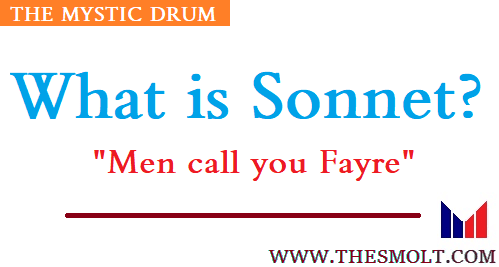What is a sonnet Men Call You Fayre
Ans. What is a Sonnet?, A sonnet is a traditional verse form having fourteen iambic pentameter lines, with one of the following rhyme schemes:
Shakespearian: abab cdcd efef gg.
Petrarchan or Italian: abba abba cde cde
or abba abba ccd eed
There is usually a break in the sense between the octave (first eight lines) and sestes (last six lines), or, in the Shakespearian sonnet, the only break is sometimes before the final couplet. There are several other variations of the rhyme scheme.

Men Call You Fayre
“Men Call You Fayre” and Poor Soul, The Centre sonnet is
prescribed in our syllabus.
Critical appreciation of “Men Call You Fayre”.
“Men Call You Fayre” is the 79th sonnet from Amoretti’s series of eighty-eight sonnets by Spenser, which illustrates the course of his courtship with Elizabeth Boyle, the woman he later married.
‘Amoretti’ is an Italian term meaning ‘little loves’ or little cupids’. This sonnet sequence is not only a collection of ‘little loves’ but a carefully constructed series of glimpses into the world of fantasy.
In the sonnet, Spenser expresses his idea of true, ever-lasting beauty. He considers spiritual beauty far more important than physical beauty. A beautiful person or object will lose physical charm but the true beauty of the spirit shall remain eternal.

Such beauty shall be derived from Divine Beauty and hence remain permanent and everlasting. The beloved is not considered just simply flesh’ but the poet considers the ‘spiritual’ being in her.
It is this spiritual beauty that he would seek to worship because doing so would be worshipping the Divine soul. That the sonnet emphasizes spiritual and intellectual beauty in a woman rather than the physical is a strikingly different feature.
This sonnet varies from the standard English pattern found in Shakespeare and combines French and English verse traditions. Though it consists of three quatrains and a final couplet, the rhyme scheme being abab, bcbc, cdcd, ee is noticeable.
Spenser here compares physical beauty with inward, spiritual beauty in a puritanical manner. Like all Renaissance men, he was alarmed by signs of returning class in the world but believed in love as an inexhaustible source of beauty and order.
This sonnet clearly exhibits the Renaissance characteristic of Neoplatonism in which Physical elements merge with spiritual ones and are transformed into the heavenly beauty of God Himself.
Read more from Mystic Drum (click)
